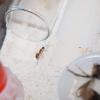Scientific Name: Camponotus nicobarensis
Common Name: Sugar ants
Distribution: Bangladesh, India, Laos, Nicobar Island, Thailand, Vietnam, China
Queen size: 13-15 mm (in a small colony)
Worker size: 5-7 mm
Median size: 9-11 mm
Major size: 10-12 mm
Natural Habitat: Rotting wood, underground
Circadian Activity: Mostly nocturnal, but if provided with food, they are willing to come out and feed.
Mating Flight: Warm sunny days or after a light rain during July to August.
Queen Founding Method: Fully Claustral
Monogyne or Polygyne: Polygmous, though it is best to introduce a queen to another when none have brood or a lone queen to a large colony.
Average time from egg to worker: 1 Month
Recommended Temperature: Summer: 72 - 82 F/ 22 - 28 C, Winter: 57 - 73 F/ 14 - 23 C
Recommended Humidity:
Preferred Foods: A steady supply of honey water and sugar water, i supply a cricket every 3 days, they have a social stomach.
Hibernation Details: None, thought their reproduction rate slows down during the winter.
Escape Barrier Methods: Alcohol + baby powder works best for me.
Difficulty rating: Very easy: Great for beginners. Hardy and do not panic (much) when put in broad daylight. Reproduce at a medium rate. Do not sting or squirt formic acid of any sort. Will accept many types of food.
Bite and/or Sting rating: Can bite but the bites are hardly noticeable. Her majesty though will not hesitate to give you a mean chomp.
Special Care or Interesting Notes: None
Additional Links: https://www.antweb.o...is&rank=species
Information submitted by Leo
- Formiculture.com
- Forums
- Gallery
- Members
- Member Map
- Chat






























